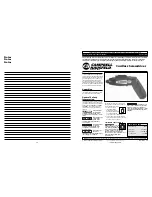
ENGLISH
31
wire will make exposed metal parts of the tool
“live" and shock the operator.
• Bits, sockets and tools get hot during
operation.
Wear gloves when touching them.
•
Do not operate this tool for long periods of
time.
Vibration caused by tool action may be
harmful to your hands and arms. Use gloves
to provide extra cushion and limit exposure by
taking frequent rest periods.
Residual Risks
In spite of the application of the relevant safety
regulations and the implementation of safety
devices, certain residual risks cannot be avoided.
These are:
–
Impairment of hearing
– Risk of personal injury due flying particles.
– Risk of burns due to accessories becoming hot
during operation.
– Risk of personal injury due to prolonged use.
Markings on Tool
The following pictograms are shown on the tool:
Read instruction manual before use.
Wear ear protection.
Wear eye protection.
DATE CODE POSITION
The Date Code, which also includes
the year of
manufacture, is printed into the housing surface that
forms the mounting joint between tool and battery.
Example:
2010 XX XX
Year of Manufacture
Important Safety Instructions for All
Battery Chargers
SAVE THESE INSTRUCTIONS:
This manual
contains important safety and operating instruc tions
for the DE9116/DE9135 battery chargers.
• Before using charger, read all instructions and
cautionary markings on charger, battery pack,
and product using battery pack.
DANGER:
Electrocution hazard.
230 volts are present at charging
terminals. Do not probe with conductive
objects. Electric shock or electrocution
may result.
WARNING:
Shock hazard. Do not allow
any liquid to get inside charger. Electric
shock may result.
CAUTION:
Burn hazard. To reduce
the risk of injury, charge only D
E
WALT
rechargeable batteries. Other types of
batteries may burst causing personal
injury and damage.
CAUTION:
Under certain conditions,
with the charger plugged in to the
power supply, the exposed charging
contacts inside the charger can be
shorted by foreign material. Foreign
materials of a conductive nature such
as, but not limited to, steel wool,
aluminum foil, or any buildup of metallic
particles should be kept away from
charger cavities. Always unplug the
charger from the power supply when
there is no battery pack in the cavity.
Unplug charger before attempting to
clean.
• DO NOT attempt to charge the battery pack
with any chargers other than the ones in
this manual.
The charger and battery pack are
specifically designed to work together.
• These chargers are not intended for
any uses other than charging D
E
WALT
rechargeable batteries.
Any other uses
may result in risk of fire, electric shock or
electrocution.
• Do not expose charger to rain or snow.
• Pull by plug rather than cord when
disconnecting charger.
This will reduce risk
of damage to electric plug and cord.
• Make sure that cord is located so that it
will not be stepped on, tripped over, or
otherwise subjected to damage or stress
.
• Do not use an extension cord unless it
is absolutely necessary.
Use of improper
extension cord could result in risk of fire,
electric shock, or electrocution.
• Do not place any object on top of charger
or place the charger on a soft surface that
might block the ventilation slots and result
in excessive internal heat.
Place the charger
in a position away from any heat source. The
charger is ventilated through slots in the top and
the bottom of the housing.
















































